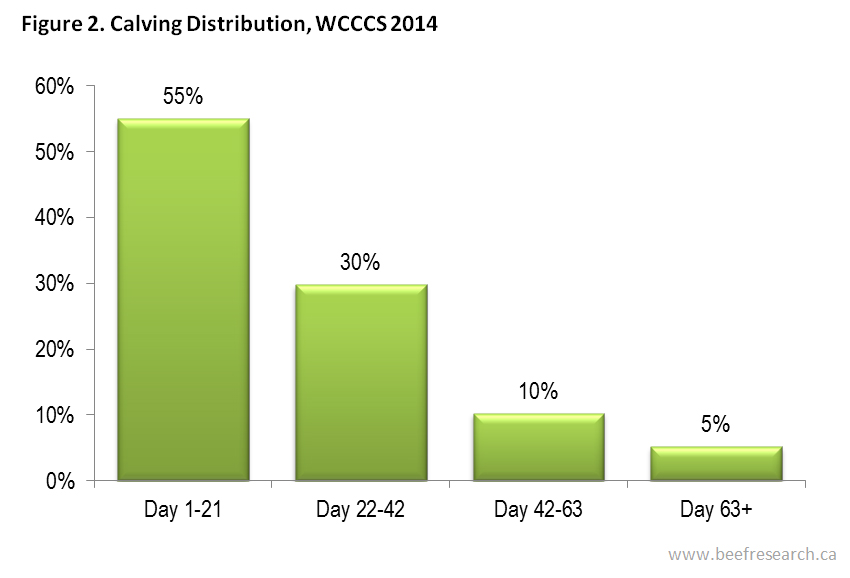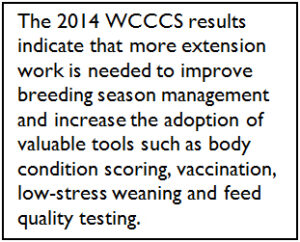Results of the Western Canadian Cow-Calf Survey: Production Benchmarks
This post was written in collaboration with Kathy Larson, MSc, PAg, Beef Economist with the Western Beef Development Centre.
Remarque : cette page web n’est actuellement disponible qu’en anglais.
Herd productivity is closely linked to herd profitability. The calculation for break-even price on calves clearly demonstrates this:

The break-even price can be lowered by decreasing total cow herd costs or by increasing the total pounds of calves weaned. Increasing the total weight (lbs) of weaned calves can be achieved by improving herd productivity, such as:
a) INCREASING – conception rates, weaning rate, etc.
b) DECREASING – calf death loss, calving span, etc.
While it is good management to track and calculate one’s herd production performance indicators on an annual basis, it can be helpful to have benchmarks to compare to. Benchmarks help a producer know if they are on the right track. They can help a producer identify if they excel in a certain area and/or could improve in another. They can also help to show what production and management practices other producers are following. Benchmark productivity measures for the cow-calf sector can also help guide research and extension efforts.
For these reasons, a group of individuals from British Columbia to Manitoba, representing provincial beef producer groups, provincial Ministry of Agriculture specialists, the Beef Cattle Research Council, Canfax and the Western Beef Development Centre have revived, expanded and conducted a survey last conducted in Alberta in 1998.
The Western Canadian Cow-Calf Survey (WCCCS) was distributed to producers from November 2014 until the end of February 2015. A total of 411 survey responses were received (representing just over 76,000 cows). Response rates varied by province with the greatest percentage of respondents being from Alberta (49%), followed by Saskatchewan (24%), Manitoba (18%) and British Columbia (8%). The average age of survey respondents was 50 with an average of 28 years in the cattle business.

Survey respondents provided details on their 2014 calf crop starting with the 2013 breeding season and ending with weaning. Cow:bull ratio averaged 25:1 and breeding season length averaged 93 days, which was nearly unchanged from the results of the ’98 Alberta survey. A breeding season no longer than 63 days is recommended to maintain a 365 day calving interval and improve calf crop uniformity, but only 24% of respondents achieved this recommended target.
Breeding heifers 4 to 6 weeks before the cows is recommended so that heifers have more time to recoup (i.e. longer post partum interval) after their first calf is born. Only 26% of survey respondents bred their heifers earlier than the rest of the herd, averaging 2 weeks earlier.
The average open rate was 7% in cows and 10% in heifers. The conception rate for all females was 92.8%, compared to 95.6% in AB in 1998. Work is underway within the industry to gain a better understanding of recent years’ lower conception rates.
The most popular month for calving start was March, with 18% starting calving in the first half of the month and 18% starting in the second half of March (see Figure 1). This is a change from 1998, where the majority of respondents were calving in February. This shift in calving start date suggests the research and extension about calving later to avoid the high cost of calving during winter months was heard and adopted.

Calving distribution is an important indicator for a herd. Ideally, 60% or more of females should be calving in the first 21 days of the calving season. A little more than 40% of question respondents achieved this target. On average 55% of females calved in the first 21 days (see Figure 2), which is an improvement from 48% reported in the 1998 AB survey.

Nearly 80% of respondents provided details on their 2014 weaning dates. Most respondents weaned in October (41%), followed by November (32%). The most common method for weaning was traditional separation (70%), with others using low-stress fenceline (22%), two-stage/nose paddle (6%) or natural (3%) weaning methods. The average wean percentage was 86%, with 533 lbs weaned per cow exposed, 28 lbs higher than in 1998. Only 24% of survey respondents implanted their 2014 calves.

More than 69% of respondents report having more than 90% polled calves. 94% of producers castrate calves before 6 months of age, indicating the vast majority of producers are already in alignment with the beef care Code of Practice requirement (to be effective Jan. 1, 2018) of using pain control when castrating bulls older than six months of age.
Over 70% of respondents sold a portion of their calves at weaning, with 9% preconditioning and 35% backgrounding. Some producers used multiple calf marketing strategies. Most respondents (80%) marketed calves via live auction, 12% sold calves direct/private treaty, 9% used electronic auction and 7% used an order buyer.
The top four bull selection criteria were breed, conformation, birth weight and EPDs, respectively. Genetic test results ranked #9 in bull selection. Few respondents test their bulls for trich (12%) and vibrio (10%).
19% of respondents regularly body condition score their females and 91% vaccinate. 47% lab test their winter feed for quality, and 80% of those use the results to balance rations.
If you are interested in learning about more WCCC survey findings please visit: www.wbdc.sk.ca/wcccs.htm. Ideally this survey will be conducted every 5 years.
Download the production indicator report (1 page PDF).
Download the overall results summary (34 page PDF).
Click here to subscribe to the BCRC Blog and receive email notifications when new content is posted.
The sharing or reprinting of BCRC Blog articles is welcome and encouraged. Please provide acknowledgement to the Beef Cattle Research Council, list the website address, www.BeefResearch.ca, and let us know you chose to share the article by emailing us at info@beefresearch.ca.
We welcome your questions, comments and suggestions. Contact us directly or generate public discussion by posting your thoughts below.
